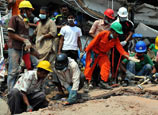
 |
| Dome and steel structure inside the defunct cement plant, which will be converted to a "cloud theater" for the biennale. |
"We imagine that people who visit the exhibition can either come here for it alone, or just come across it when they're taking a walk with their children," Zhang explains. A second difference, he goes on to explain, is in the theme — Reflecta and Fabrica — two Latin words that could describe Shanghai's history over the past three decades.
"A retrospective look at Shanghai's developmental history reveals the rise of China," Zhang adds, "over the past 30 years, its construction work, development, and urbanization have been speeding up.
"We use the Latin word ‘fabrica', which means to make, to express the deeper meaning of the historical process, not only in the past but also at present and in the future. But, despite the continuing development, we also need to reflect on and review the past to construct a historical attitude toward the development — that's the ‘reflecta'."
Another difference is the fact that this biennale will create a dialogue between architecture and other art forms, such as film and sound art. Why is that needed? Because, as Zhang says, for many people, architecture is the art of space, but it is also an art of time, which is always changing in illumination by day or night. And the other art forms will bring more change to architecture in the dialogue.


















 Children in quake-hit areas in Sichuan
Children in quake-hit areas in Sichuan


![]()
